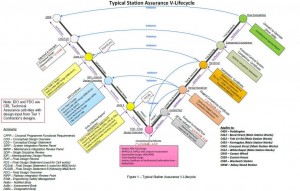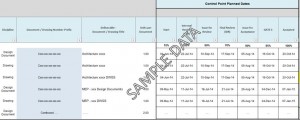
Crossrail Approach to Managing and Planning Design
Document
type: Micro-report
Author:
Sarah Fennell BEng
Publication
Date: 26/02/2016
-
Abstract
Planning of detailed design is often seen as abstract and difficult to measure progress against. This learning legacy paper describes how Crossrail, in conjunction with the design gates in the V-Lifecycle (Validation and Verification) technical assurance process, developed a detailed design programme in P6 and learned lessons in the capturing of progress and performance from contractors as well as the importance of communication at all tiers of the planning function.
-
Read the full document
Introduction
Detailed design to RIBA Stages E and F, for Crossrail’s stations, portals and shafts and Systemwide Works, formed part of the Tier 1 contractors’ main scope of works. Crossrail required clear visibility of the detailed design through approvals and assurance gates. Accordingly a set of procedures were developed to manage and report on the design progress.
V-Lifecycle
As part of Crossrail’s technical assurance strategy, a design gate programme was developed based on the V lifecycle shown in Figure 1.
The V-Lifecycle is a stepped process with each step verifying that the previous step meets the requirements and validates that the needs of the concept model are met.
The left of the “V” denotes project definition and the right; project testing and integration.
Figure 1 – Typical Station Assurance V-Lifecycle
Detailed Design Programme
In conjunction with the V-Lifecycle a detailed design programme was developed showing the typical sequence of activities that satisfied the requirements. This was developed in P6 as a fragnet* with specific Engineering Codes populated.
The approach was implemented using a desktop instruction** (Section 3.8 of the Crossrail Planning and Scheduling Handbook), that was issued to both the Crossrail and contractors project teams.
*A Fragnet is a pre-built plan in Primavera P6 that can be imported into existing programmes and adjusted to meet the needs of the specific project.
** Desktop instructions offer guidance and best practice to the planning department and collectively form the Crossrail Planning & Schedule Handbook.
The key design review activities were identified as follows:
- SDR – Single Disciplinary Design Review
- IDR – Inter-Disciplinary Design Review
- Gate 3 – Design Assurance Gate (RIBA F)
- FDS (B) – Final Design Statement
- CRL Technical Assurance activities:
- IDO – Interim Design Overview
- FDO – Final Design Overview
Reporting and Performance
Engineering Progress & Performance Report (EPPR)
To capture the progress and performance of the contractors design, an EPPR template was developed as shown in Figure 2 and issued as a project manager’s instruction (PMI) to the contractors.
The EPPR is a tool used to measure design progress and performance. It is essentially a list of engineering deliverables with dates shown for the design reviews, known as control points.
Progress is only earned as the design deliverable passes through the control point, with a pre-defined percentage (weighting) associated.
Figure 2: EPPR data input sheet example
Figure 3: EPPR dashboard example
The output of the EPPR was a cumulative S-Curve which formed part of the EPPR dashboard as shown in Figure 3, updated periodically and submitted as part of the Crossrail dashboard.
Detailed Design Tracker
The detailed design tracker reported on the main design reviews and assurance gates for the stations, portals & shafts and also for systemwide contracts. The tracker was updated periodically using the level 2 Primavera programmes and was measured against the baseline. The data was extracted from Primavera using the engineering codes assigned.
The report was run in draft prior to lockdown of the level 2 Primavera schedules (end of week 4). It was circulated to the planning team, project managers, engineering managers and technical assurance team for comment and further update if necessary. The Final version was published following period lockdown (Wednesday week 1)
Figure 4 Detailed Design tracker for Stations, Portals and Shafts
Publishing Reports
The reports mentioned were published each period on the detailed design portal (shown in figure 5) on the Crossrail planning website which was available to all within the Crossrail team. Along with this, and for a comprehensive view, the detailed design programme was extracted from the Primavera Programmes and published each period.
Figure 5: Snap Shot of the Detailed Design Portal
Lessons Learned and Recommendations
Detailed design is often looked upon as abstract and difficult to measure progress against, it was therefore beneficial using the EPPR as a means of measuring progress. The control points and the percentages apportioned to them were identified at contract level however the business may have benefited more had the control points being defined centrally and rolled out.
Reporting overall progress was difficult, mainly due to the EPPR template being adapted by each contractor in a different manner to suit their needs. The template could be further developed so that data extraction would be easier, enabling overall progress rollup more proficiently.
After much exploration, the detailed design tracker presented in a matrix format, was deemed most suitable to summarise the numerous review dates on a page. To help digest this information, conditional formatting was applied. Including Red indicating negative variance from the baseline, Green; positive, Orange; forecast in the 4 week lookahead.
The tracker was developed well advance of starting on site, and perhaps in hindsight more focus should have gone to this area and measuring programme impact due to late design approval.
Occasionally, to enable installation to commence for certain elements of work, but prior to the late running Gate 3 approval – a mini gate would be required to cover just that element of work. There were procedures set up in Primavera to capture these, however the process would benefit from further development.
Perhaps the most important lessons learned was the importance of communication:-
- It is essential that the project teams communicate with their planners, so that the Primavera information extracted will be accurate, reducing errors and therefore preventing iterations to reports
- It is essential that the contractor communicates with the project team via the means identified through a clearly defined process and methodology to plan, manage and report the progress of detailed design.
- It is essential that the project teams communicate with the technical assurance directorate so that resourcing, scheduling and expectations can be managed.
- Tier 1 Contractors can be poor at managing Design Consultants. Care should be taken to ensure that competent design engineering resources are selected to manage the detailed design process; the quality of information supplied and communication with the project planning team.
-
Authors
Sarah Fennell BEng - Crossrail Ltd
Sarah Fennell has been working in the rail industry for over 12 years focusing on Earned Value Management, Programme Controls and Planning. Sarah holds a BEng in Production Engineering and has been involved in the Crossrail project for four years.




